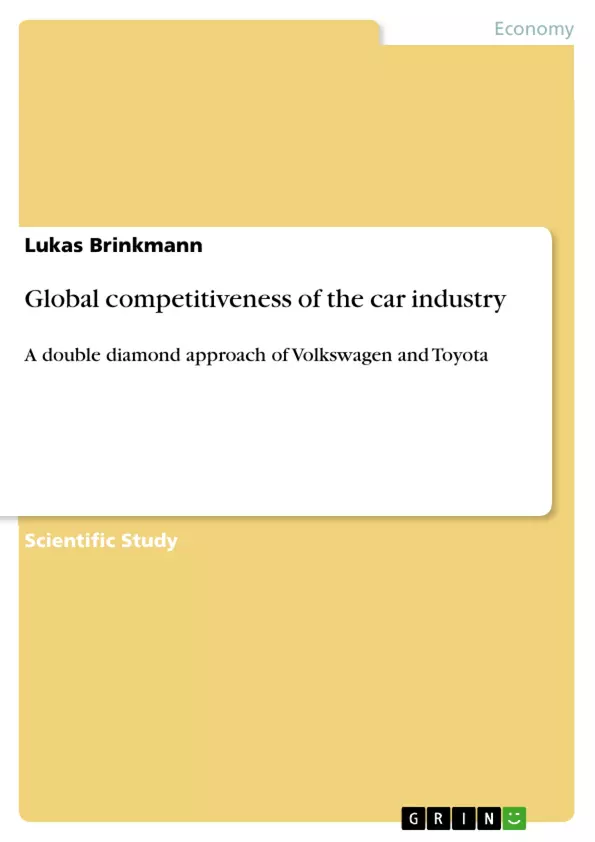After purchasing the German sports car producer Porsche AG, Europe’s biggest car company, the Volkswagen AG (VW) is now made up of ten brands. After several years of sustainable growth and acquisitions, VW’s aim is to outstrip the leading Japanese car company Toyota Motor Corporation (Toyota). Impressive key figures, a successful global growth strategy and possibly further aqcuisitions may be some key points to achieve their ultimate aim of being the world’s biggest car producer by 2018. To give us a more detailed picture a generalized double diamond approach will examine the global competitiveness of both VW and Toyota.
Inhaltsverzeichnis (Table of Contents)
- INTRODUCTION
- Company Profile
- Reason and Concern of this Research Study
- DETERMINANTS AND DESCRIPTIVE DATA
- Firm Strategy, Structure and Rivalry
- Domestic Firm Strategy, Structure and Rivalry
- International Firm Strategy, Structure and Rivalry
- Factor Conditions
- Domestic Factor Conditions
- International Factor Conditions
- Demand Conditions
- Domestic Demand Conditions
- International Demand Conditions
- Related and Supporting Industries
- Domestic Related and Supporting Industries
- International Related and Supporting Industries
- EMPIRICAL RESULTS
- Calculations
- The Domestic Diamond
- The International Diamond
- UPSHOT
Zielsetzung und Themenschwerpunkte (Objectives and Key Themes)
This research study aims to analyze the global competitiveness of Volkswagen (VW) and Toyota Motor Corporation (Toyota) by applying the generalized double diamond model. The study focuses on comparing the determinants of competitiveness for both companies in both domestic and international markets, using descriptive data and a weighting system to create a score scale.
- Global competitiveness of the car industry
- Comparative analysis of Volkswagen and Toyota using the double diamond model
- Determinants of competitiveness in domestic and international markets
- Evaluation of firm strategy, structure, rivalry, factor conditions, demand conditions, and related and supporting industries
- Assessment of strengths and weaknesses of both companies in various aspects of their operations
Zusammenfassung der Kapitel (Chapter Summaries)
- INTRODUCTION: This chapter provides a brief company profile of both VW and Toyota, highlighting their key characteristics, product ranges, and market positions. It also outlines the research study's rationale and concern, emphasizing the importance of analyzing competitiveness in a global context.
- DETERMINANTS AND DESCRIPTIVE DATA: This chapter introduces Porter's diamond model and its four determinants: firm strategy, structure, and rivalry; factor conditions; demand conditions; and related and supporting industries. The chapter outlines the selected proxy variables and their weights for each determinant, both domestically and internationally.
- EMPIRICAL RESULTS: This chapter presents the calculations and analysis of the descriptive data for both VW and Toyota. It covers the domestic diamond, comparing the strengths and weaknesses of both companies based on their domestic performance. The chapter also delves into the international diamond, assessing the competitive advantages and disadvantages of each company in the global market.
Schlüsselwörter (Keywords)
The key keywords and focus topics of this research study include global competitiveness, car industry, Volkswagen, Toyota, double diamond model, firm strategy, factor conditions, demand conditions, related and supporting industries, domestic market, international market, descriptive data, weighting system, strengths, weaknesses, competitive advantages, and competitive disadvantages. The study utilizes these keywords to explore the complex factors influencing the global competitiveness of VW and Toyota in the dynamic automotive industry.
- Quote paper
- Bachelor of Arts Lukas Brinkmann (Author), 2009, Global competitiveness of the car industry, Munich, GRIN Verlag, https://www.grin.com/document/168107



